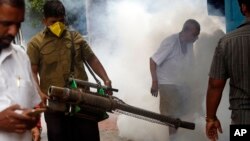The World Health Organization (WHO) has stepped up its warning for Southeast Asia to guard against the threat posed by the mosquito-borne Zika virus, amid mounting concerns in the region of the impact to local populations.
Roderico Ofrin, WHO regional emergencies director for Southeast Asia, said countries need to adopt “effective surveillance and reporting systems” to closely monitor the spread of the disease.
“WHO is working with countries across the South East Asia region to continue to prevent, detect ,and respond to Zika virus transmission,” Ofrin said in emailed comments to VOA.
Illness surveillance
The strategy “emphasizes the ongoing importance of enhancing vector control; strengthening Zika virus and birth-defect surveillance, scaling up laboratory capacity and amplifying risk communication and community engagement,” he said.
A report in The Lancet Infectious Diseases journal identified India, China, the Philippines, Thailand and Indonesia as high-risk countries, while in Sub-Saharan Africa, Angola has faced increased risks due to its historical ties with Brazil.
The Lancet warned that “at least 2.6 billion people – over a third of the global population, living in Africa, Asia and the Pacific were vulnerable to the Zika virus.
Pregnant women at risk
At most risk are pregnant women. Becoming infected with a virus strain now impacting populations in South America can result in child birth defects, especially microcephaly, affecting normal development of an infant’s head.
The virus is also transmitted through sexual contact, blood transfusions and from mother to child, and has been linked to muscle weakening and paralysis due to damaged nerve cells known as Guillain-Barre syndrome.
South America has borne the brunt of the virus’ severe impact, especially Brazil, where hundreds of cases of microcephaly have been confirmed since the outbreak in 2015.
Southeast Asian governments have stepped up surveillance and detection of the virus in communities, with chemical sprays over areas known as breeding grounds for the Aedes mosquito.
Singapore has reported more than 240 Zika cases, while Malaysia and Thailand have also reported infections. Travel warnings have also been posted by the United States, Britain, Australia and Taiwan, warning pregnant women against nonessential travel.
But Asian-based scientists say the latest outbreak has left many questions unanswered.
A strain of the Zika virus has been embedded in Asia for many years and associated with a mild fever, rash and joint pains, which doctors say pass after a week of treatment. The Zika virus, as a result, has received less attention than more virulent diseases such as dengue fever and malaria.
Monitoring breeding grounds
In 2016 Thailand alone has reported more than 35,800 cases of dengue with more than two dozen casualties.
Singapore’s Ministry of Health and National Environment Agency reported the Zika virus strain affecting the community in recent weeks came from within Asia, and not imported from Brazil.
Prasert Auewarakul, a professor and director of the Institute of Molecular Biosciences at Mahidol University, says identifying the strains of virus is key, and whether the outbreak is a virulent as the episodes in South America.
“Basically, [the strains] are very similar in terms of evolution. People believe the South American strain came from the Southeast Asian strain,” Prasert said.
“The big puzzle is that even though we have had the Southeast Asian strain in the region for many years, nothing big has happened so far,” he said.
Prasert says Thai authorities are focusing surveillance “on case detection," so with the increasing risk people at the [Thai] Ministry of Public Health, “are trying hard to identify cases to control so it doesn’t spread."
But others, such as Voravit Suwanvanichkij from the Johns Hopkins School of Medicine, and those working with refugee charities along the Thai Myanmar border, are more cautious. Voravit says if Zika infections were to increase, “there’s a very real risk that we actually establish a new endemic disease here."
“That’s the biggest fear, especially since the most feared complication is this microcephaly – causing their children to be born with abnormally small heads,” he said.
Local Thai news agencies reported a senior official from the Ministry of Public Health’s Department of Disease Control saying so far Zika is not considered serious with as yet no critical outbreak.
Thai Public Health Ministry officials say in Chiang Mai’s San Sai district, two women, six months and eight months pregnant, are being closely monitored by medical staff.
Voravit says officials and the general public should not be complacent.
“The reality is that this shouldn’t be something that makes us let down our guard. The potential is there and we’re still in many ways still learning about this disease and now wouldn’t be the time to let the guard down,” he told VOA.
He says the risk of infections in urban areas is high, especially as the Aedes mosquito that carries the virus is well adapted to “living around people and its human settlements."
He says the concern is “if you just get the critical level in the amount of people infected you can usually touch off an epidemic.”











